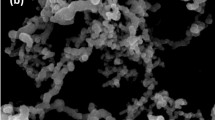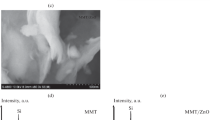Abstract
Pickering emulsion method is used to construct photo-responsive metal-free microcapsules comprising graphitic carbon nitride (g-C3N4) nanosheets dispersed in montmorillonite (Mt) colloidosomes. Morphology characterization revealed a spherical-shaped microcapsule with diameter ranges from 5 to 50 µm. Cr (VI) was employed as a target contaminant to evaluate the photocatalytic performance of the microcapsules. Batch investigation showed pH 3 to be the optimal condition with a complete Cr (VI) removal. XPS analysis proved that the as-prepared microcapsule is able to reduce Cr (VI) to Cr (III).






Similar content being viewed by others
References
Prasad S, Yadav KK, Kumar S, Gupta N, Cabral-Pinto MMS, Rezania S, Radwan N, Alam J (2021) Chromium contamination and effect on environmental health and its remediation: a sustainable approaches. J Environ Manag 285:174–195. https://doi.org/10.1016/j.jenvman.2021.112174
Acharya R, Martha S, Parida K (2017) Remediation of Cr (VI) using clay minerals, biomasses and industrial wastes as adsorbents, Adv Mater Wastewater Treat, 129–170. https://doi.org/10.1002/9781119407805.ch5
Liu B, Chen C, Li W, Liu H, Liu L, Deng S, Li Y (2022) Effective removal of Cr(VI) from aqueous solution through adsorption and reduction by magnetic S-doped Fe–Cu–La trimetallic oxides. J Environ Chem Eng 10:107433. https://doi.org/10.1016/j.jece.2022.107433
Acharya R, Naik B, Parida KM (2018) Adsorption of Cr (VI) and textile dyes on to mesoporous silica, titanate nanotubes, and layered double hydroxides. Nanomater Wet Process Text, 219–260. https://doi.org/10.1002/9781119459804.ch7
Acharya R (2020) A review on adsorptive remediation of Cr (VI) by magnetic iron oxides and their modified forms. Biointerface Res Appl Chem 10:5266–5272. https://doi.org/10.33263/BRIAC102.266272
Attia AA, Khedr SA, Elkholy SA (2010) Adsorption of chromium ion (VI) by acid activated carbon. Braz J Chem Eng 27:183–193. https://doi.org/10.1590/S0104-66322010000100016
Ren YQ, Sun SY, Acheampong EO, Dong FQ, Ma BB, Wang K, Fan XY (2020) One-step synthesis of visible-responsive diatomite/g-C3N4 composite and its catalytic degradation for Cr(VI). Mater Sci Forum 993:1391–1400. https://doi.org/10.4028/www.scientific.net/MSF.993.1391
Ksakas A, Loqman A, Bali BE, Taleb M, Kherbeche A (2015) The adsorption of Cr (VI) from aqueous solution by natural materials. J Mater Environ Sci 6:2003–2012
Mishra S, Acharya R (2021) Photocatalytic applications of graphene based semiconductor composites: a review. Mater Today Proc 35:164–169. https://doi.org/10.1016/j.matpr.2020.04.066
Zhang J, Chen Y, Wang X (2015) Two-dimensional covalent carbon nitride nanosheets: synthesis, functionalization, and applications. Energy Environ Sci 8:3092–3108. https://doi.org/10.1039/C5EE01895A
Wen J, Xie J, Chen X, Li X (2017) A review on g-C3N4-based photocatalysts. Appl Surf Sci 391:72–123. https://doi.org/10.1016/j.apsusc.2016.07.030
Cheng J, Hu Z, Lv K, Wu X, Li Q, Li Y, Li X, Sun J (2018) Drastic promoting the visible photoreactivity of layered carbon nitride by polymerization of dicyandiamide at high pressure. Appl Catal B Environ 232:330–339. https://doi.org/10.1016/j.apcatb.2018.03.066
Acharya R, Pati S, Parida K (2022) A review on visible light driven spinel ferrite-g-C3N4 photocatalytic systems with enhanced solar light utilization. J Mol Liq 357:119105. https://doi.org/10.1016/j.molliq.2022.119105
Singh J, Kumari P, Basu S (2019) Degradation of toxic industrial dyes using SnO2/g-C3N4 nanocomposites: role of mass ratio on photocatalytic activity. J Photochem Photobiol A Chem 371:136–143. https://doi.org/10.1016/j.jphotochem.2018.11.014
Cao S-W, Liu X-F, Yuan Y-P, Zhang Z-Y, Liao Y-S, Fang J, Loo SCJ, Sum TC, Xue C (2014) Solar-to-fuels conversion over In2O3/g-C3N4 hybrid photocatalysts. Appl Catal B Environ 147:940–946. https://doi.org/10.1016/j.apcatb.2013.10.029
Xiao Y, Tao X, Qiu G, Dai Z, Gao P, Li B (2019) Optimal synthesis of a direct Z-scheme photocatalyst with ultrathin W18O49 nanowires on g-C3N4 nanosheets for solar-driven oxidation reactions. J Colloid Interface Sci 550:99–109. https://doi.org/10.1016/j.jcis.2019.04.081
Li P, Huang L, Li Y, Xu Y, Huang S, Yuan D, Xu H, Li H (2017) Synthesis of dark orange montmorillonite/g-C3N4 composites and their applications in the environment. J Phys Chem Solids 107:131–139. https://doi.org/10.1016/j.jpcs.2017.03.023
Martins IM, Barreiro MF, Coelho M, Rodrigues AE (2014) Microencapsulation of essential oils with biodegradable polymeric carriers for cosmetic applications. Chem Eng J 245:191–200. https://doi.org/10.1016/j.cej.2014.02.024
Lee JW, Kong S, Kim W-S, Kim J (2007) Preparation and characterization of SiO2/TiO2 core-shell particles with controlled shell thickness. Mater Chem Phys 106:39–44. https://doi.org/10.1016/j.matchemphys.2007.05.019
Lin S, Sun S, Wang K, Shen K, Ma B, Ren Y, Fan X (2018) Bioinspired design of alcohol dehydrogenase@ nano TiO2 microreactors for sustainable cycling of NAD+/NADH coenzyme. Nanomaterials 8:127. https://doi.org/10.3390/nano8020127
Huo C, Li M, Huang X, Yang H, Mann S (2014) Membrane engineering of colloidosome microcompartments using partially hydrophobic mesoporous silica nanoparticles. Langmuir 30:15047–15052. https://doi.org/10.1021/la503958d
Lin S, Sun S, Shen K, Tan D, Zhang H, Dong F, Fu X (2018) Photocatalytic microreactors based on nano TiO2-containing clay colloidosomes. Appl Clay Sci 159:42–49. https://doi.org/10.1016/j.clay.2017.08.022
Chevalier Y, Bolzinger M-A (2013) Emulsions stabilized with solid nanoparticles: pickering emulsions. Colloids Surf A Physicochem Eng Asp 439:23–34. https://doi.org/10.1016/j.colsurfa.2013.02.054
Ridha Djellabi MFG, Bianchi CL, Cerrato G, Morandi S (2016) Removal of crystal violet and hexavalent chromium using TiO2-bentonite under sunlight: effect of TiO2 content. J Chem Eng Process Technol 7:1–8. https://doi.org/10.4172/2157-7048.1000276
Xu C, Gu FL, Wu H (2017) BiOCl-montmorillonite as a photocatalyst for highly efficient removal of Rhodamine B and Orange G: importance of the acidity and dissolved oxygen. Appl Clay Sci 147:28–35. https://doi.org/10.1016/j.clay.2017.07.025
Sani HA, Ahmad MB, Hussein MZ, Ibrahim NA, Musa A, Saleh TA (2017) Nanocomposite of ZnO with montmorillonite for removal of lead and copper ions from aqueous solutions. Process Saf Environ Prot 109:97–105. https://doi.org/10.1016/j.psep.2017.03.024
Guo Y, Li C, Guo Y, Wang X, Li X (2019) Ultrasonic-assisted synthesis of mesoporous g-C3N4/Na-bentonite composites and its application for efficient photocatalytic simultaneous removal of Cr(VI) and RhB. Colloids Surf A Physicochem Eng Asp 578:123624. https://doi.org/10.1016/j.colsurfa.2019.123624
Ma B, Sun S, He H, Lv R, Deng J, Huo T, Zhao Y, Yu H, Zhou L (2019) An efficient metal-free photocatalytic system with enhanced activity for NADH regeneration. Ind Eng Chem Res 58:23567–23573. https://doi.org/10.1021/acs.iecr.9b05038
Huang M, Xu C, Wu Z, Huang Y, Lin J, Wu J (2008) Photocatalytic discolorization of methyl orange solution by Pt modified TiO2 loaded on natural zeolite. Dyes Pigments 77:327–334
Wang Y, Li Y, Zhao J, Wang J, Li Z (2019) g-C3N4/B doped g-C3N4 quantum dots heterojunction photocatalysts for hydrogen evolution under visible light. Int J Hydrogen Energy 44:618–628. https://doi.org/10.1016/j.ijhydene.2018.11.067
Ding J, Wang L, Liu Q, Chai Y, Liu X, Dai W-L (2015) Remarkable enhancement in visible-light absorption and electron transfer of carbon nitride nanosheets with 1% tungstate dopant. App Catal B Environ 176–177:91–98. https://doi.org/10.1016/j.apcatb.2015.03.028
Gnanaprakasam A, Sivakumar VM, Thirumarimurugan M (2015) Influencing parameters in the photocatalytic degradation of organic effluent via nanometal oxide catalyst: a review. Indian J Materals Sci 2015:16. https://doi.org/10.1155/2015/601827
Zhu S, Liao W, Zhang M, Liang S (2019) Design of spatially separated Au and CoO dual cocatalysts on hollow TiO2 for enhanced photocatalytic activity towards the reduction of CO2 to CH4. Chem Eng J 361:461–469. https://doi.org/10.1016/j.cej.2018.12.095
Chowdhury SR, Yanful EK, Pratt AR (2012) Chemical states in XPS and Raman analysis during removal of Cr(VI) from contaminated water by mixed maghemite–magnetite nanoparticles. J Hazard Mater 235–236:246–256. https://doi.org/10.1016/j.jhazmat.2012.07.054
Shen Y-S, Wang S-L, Huang S-T, Tzou Y-M, Huang J-H (2010) Biosorption of Cr(VI) by coconut coir: spectroscopic investigation on the reaction mechanism of Cr(VI) with lignocellulosic material. J Hazard Mater 179:160–165. https://doi.org/10.1016/j.jhazmat.2010.02.073
Feng B, Shen W, Shi L, Qu S (2018) Adsorption of hexavalent chromium by polyacrylonitrile-based porous carbon from aqueous solution. R Soc Open Sci 5:1–13. https://doi.org/10.1098/rsos.171662
Daulton T, Little B (2006) Determination of chromium valence over the range Cr(0)-Cr(VI) by electron energy loss spectroscopy. Ultramicroscopy 106:561–573. https://doi.org/10.1016/j.ultramic.2006.02.005
Rajput S, Pittman CU, Mohan D (2016) Magnetic magnetite (Fe3O4) nanoparticle synthesis and applications for lead (Pb2+) and chromium (Cr6+) removal from water. J Colloid Interface Sci 468:334–346. https://doi.org/10.1016/j.jcis.2015.12.008
Owalude SO, Tella AC (2016) Removal of hexavalent chromium from aqueous solutions by adsorption on modified groundnut hull. Beni-Suef Univ J Basic Appl Sci 5:377–388. https://doi.org/10.1016/j.bjbas.2016.11.005
Gao X, Guo C, Hao J, Zhang Y, Li M, Zhao Z (2022) Efficient removal of Cr (VI) by modified sodium alginate via synergistic adsorption and photocatalytic reduction. Appl Surf Sci 579:152259–152270. https://doi.org/10.1016/j.apsusc.2021.152259
Weng CH, Wang JH, Huang CP (1997) Adsorption of Cr(VI) onto TiO2 from dilute aqueous solutions. Water Sci Technol 35:55–62. https://doi.org/10.1016/S0273-1223(97)00114-5
Chen X, Zhang Y, Yuan D, Huang W, Ding J, Wan H, Dai W-L, Guan G (2021) One step method of structure engineering porous graphitic carbon nitride for efficient visible-light photocatalytic reduction of Cr(VI). J Mater Sci Technol 71:211–220. https://doi.org/10.1016/j.jmst.2020.09.008
Pavasaryte L, Balu S, Yang TCK (2019) Synthesis of sol–gel derived holmium aluminium garnet on exfoliated g-C3N4: a novel visible-light-driven Z-scheme photocatalyst for the degradation of sunset yellow FCF. J Mater Sci Mater Electron 30:20132–20143. https://doi.org/10.1007/s10854-019-02387-6
Xia Y, Xu L, Peng J, Han J, Guo S, Zhang L, Han Z, Komarneni S (2019) TiO2@g-C3N4 core/shell spheres with uniform mesoporous structures for high performance visible-light photocatalytic application. Ceram Int 45:18844–18851. https://doi.org/10.1016/j.ceramint.2019.06.118
Li Y, Zhan J, Huang L, Xu H, Li H, Zhang R, Wu S (2014) Synthesis and photocatalytic activity of a bentonite/g-C3N4 composite. RSC Adv 4:11831–11839. https://doi.org/10.1039/C3RA46818F
Acharya L, Mishra BP, Pattnaik SP, Acharya R, Parida K (2022) Incorporating nitrogen vacancies in exfoliated B-doped g-C3N4 towards improved photocatalytic ciprofloxacin degradation and hydrogen evolution. New J Chem 46:3493–3503. https://doi.org/10.1039/D1NJ05838J
An D-S, Zeng H-Y, Xiao G-F, Xiong J, Chen C-R, Hu G (2020) Cr(VI) reduction over Ag3PO4/g-C3N4 composite with p-n heterostructure under visible-light irradiation. J Taiwan Inst Chem Eng 117:133–143. https://doi.org/10.1016/j.jtice.2020.12.012
Barathi D, Rajalakshmi N, Ranjith R, Sangeetha R, Meyvel S (2021) Controllable synthesis of CeO2/g-C3N4 hybrid catalysts and its structural, optical and visible light photocatalytic activity. Diam Relat Mater 111:108161. https://doi.org/10.1016/j.diamond.2020.108161
Ou B, Wang J, Wu Y, Zhao S, Wang Z (2020) Efficient removal of Cr (VI) by magnetic and recyclable calcined CoFe-LDH/g-C3N4 via the synergy of adsorption and photocatalysis under visible light. Chem Eng J 380:122600. https://doi.org/10.1016/j.cej.2019.122600
Wang H, Li Q, Zhang S, Chen Z, Wang W, Zhao G, Zhuang L, Hu B, Wang X (2019) Visible-light-driven N2-g-C3N4 as a highly stable and efficient photocatalyst for bisphenol A and Cr(VI) removal in binary systems. Catal Today 335:110–116. https://doi.org/10.1016/j.cattod.2018.09.037
Cui L, Fang Z, Liu Y, Chen M, Yin C, Wang J, Wang Z-g, Dong M, Kang S, Liu P (2019) Moderate NaNO2 etching enables easy crystallinity optimization of g-C3N4 with superior photoreduction performance. Inorg Chem Front. https://doi.org/10.1039/C9QI00113A
Lamkhao S, Rujijanagul G, Randorn C (2018) Fabrication of g-C3N4 and a promising charcoal property towards enhanced chromium(VI) reduction and wastewater treatment under visible light. Chemosphere 193:237–243. https://doi.org/10.1016/j.chemosphere.2017.11.015
Acknowledgements
This work was jointly supported by the National Natural Science Foundation of China (NSFC, Grant Numbers 42061134018, 42011530085), the Russian Science Foundation (RSF, Grant Number 21-47-00019) and the Doctoral Research Foundation (Including Talent Introduction) Project of Southwest University of Science and Technology (Grant Number 22zx7173).
Author information
Authors and Affiliations
Corresponding author
Ethics declarations
Conflict of interest
All authors declare that they have no conflicts of interest.
Additional information
Publisher's Note
Springer Nature remains neutral with regard to jurisdictional claims in published maps and institutional affiliations.
Rights and permissions
Springer Nature or its licensor (e.g. a society or other partner) holds exclusive rights to this article under a publishing agreement with the author(s) or other rightsholder(s); author self-archiving of the accepted manuscript version of this article is solely governed by the terms of such publishing agreement and applicable law.
About this article
Cite this article
Acheampong, E.O., Wang, K., Lv, R. et al. Montmorillonite-based photoresponsive microcapsules for efficient removal of chromium. J Radioanal Nucl Chem 332, 3675–3686 (2023). https://doi.org/10.1007/s10967-023-09039-4
Received:
Accepted:
Published:
Issue Date:
DOI: https://doi.org/10.1007/s10967-023-09039-4




